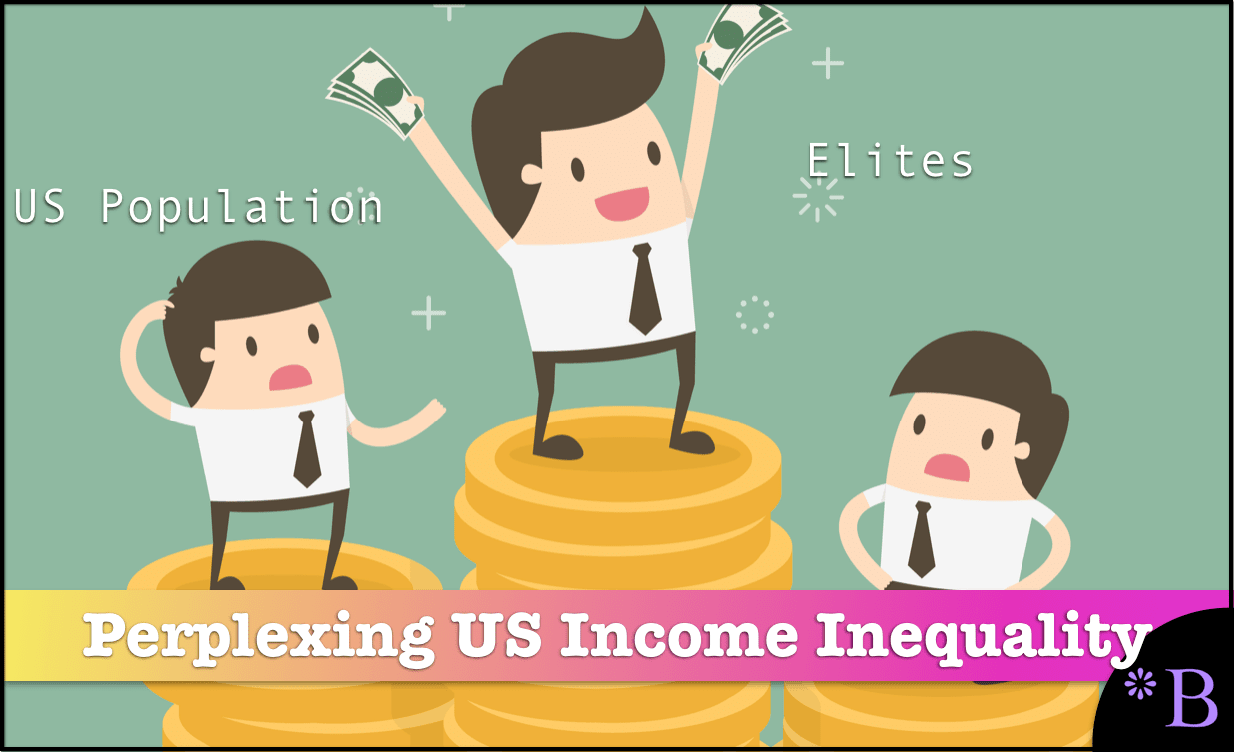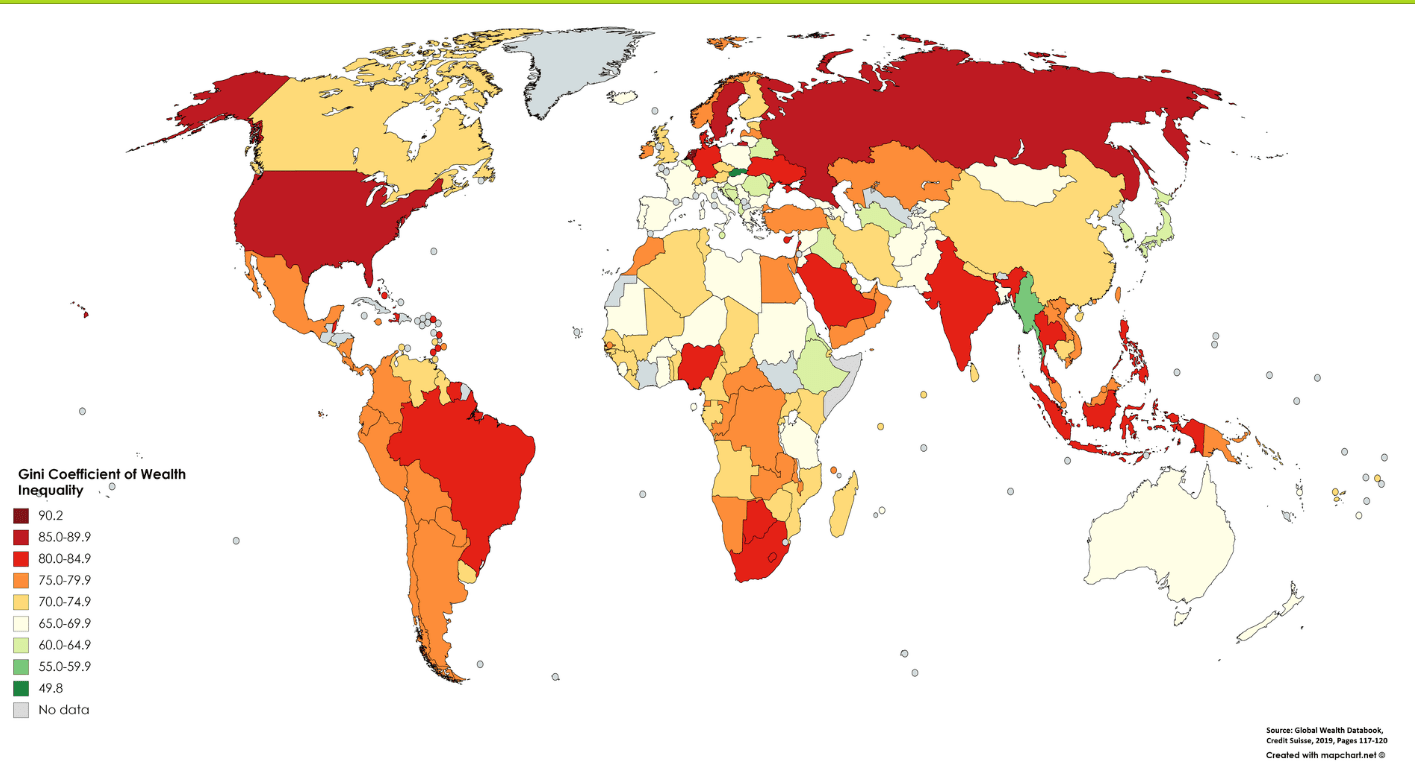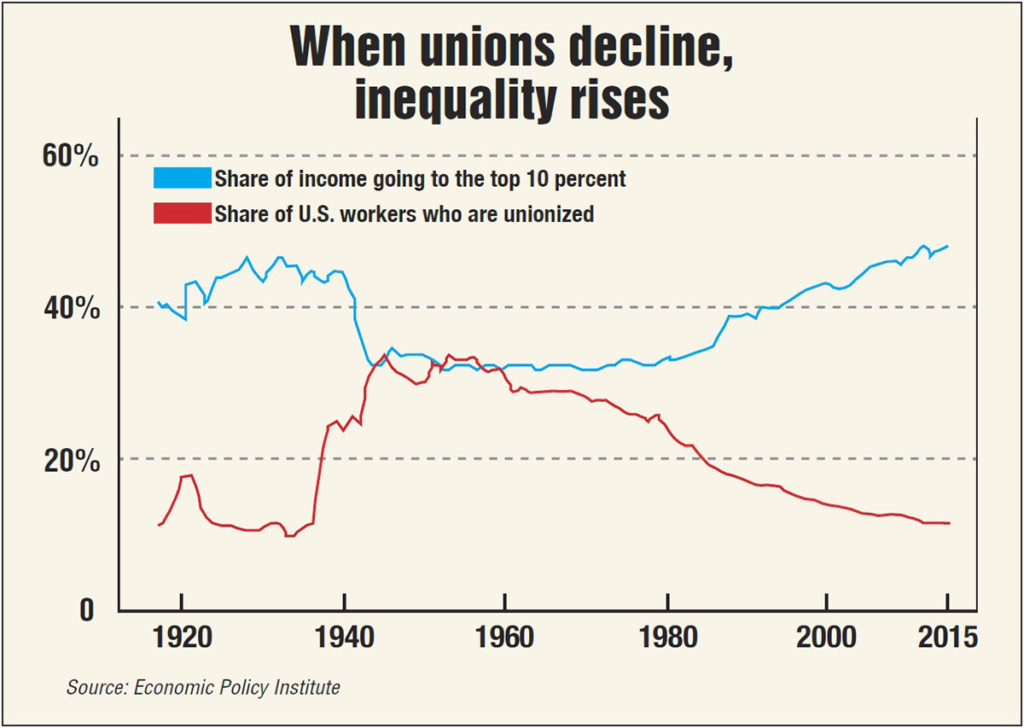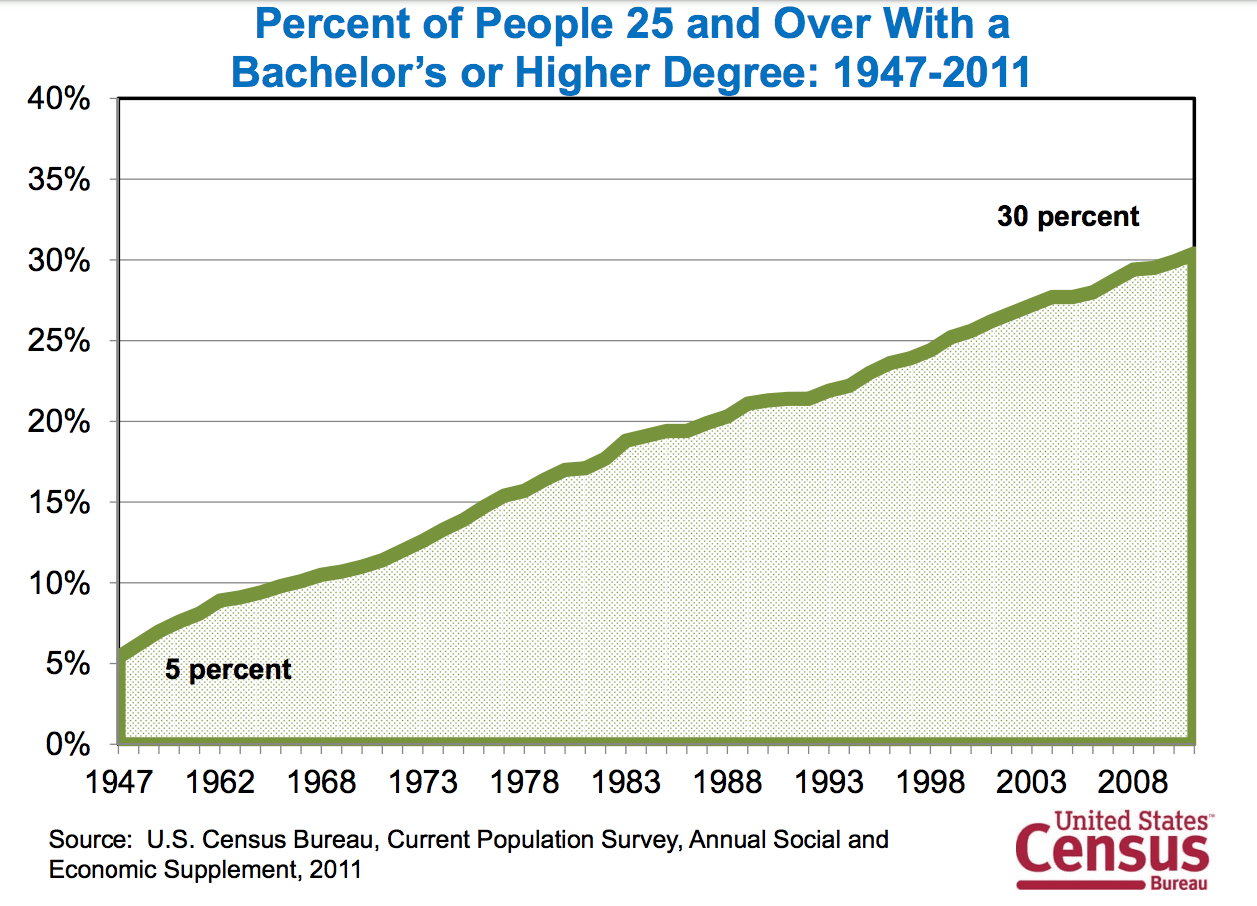How Does the US Have an Income Inequality of a Preindustrialized Country?
Executive Summary
- The US has a shocking income inequality or Gini coefficient.
- We cover the inconsistencies with this inequality given the nation’s history.

Introduction
The Gini coefficient is a measurement of income inequality in society. It is calculated yearly by the World Bank. The higher the number, the more unequal the society.
The Gini coefficient is described in the following quotation.
The Gini coefficient, also called the Gini Index or Gini ratio, is a statistical measure of distribution intended to represent the income or wealth distribution. The Gini coefficient was developed by Italian statistician Corrado Gini in 1912 and is the most commonly used measurement of wealth or income inequality.
The Gini coefficient ranges from 0 (0%) to 1 (100%), with 0 representing perfect equality and 1 representing perfect inequality.
While the Gini coefficient is a useful tool for analyzing the wealth or income distribution in a country, it should not indicate its overall wealth or income. Some of the world’s poorest countries, such as the Central African Republic, have some of the highest Gini coefficients (61.3 in this case). – World Population Review
The following list of countries is a subset of the countries close to the US in their Gini coefficient. And it tells an interesting story about what has happened to the US economy and politics.
Our References for This Article
If you want to see our references for this article and other related Brightwork articles, visit this link.
Here is a map of the Gini coefficient around the world.

*Source: Wikipedia
There are two Gini coefficients.
One for wealth, and a second for income.
The map above is the wealth Gini coefficient. In this next section, I will use the Gini numbers for income to begin and then use numbers for wealth.
Gini Coefficient For Income For the US and Countries Close to the US
| Country | Gini Co | Year Recorded |
|---|---|---|
| Democratic Republic of Congo | 42.1 | 2012 |
| Papua New Guinea | 41.9 | 2009 |
| Turkey | 41.9 | 2018 |
| Ivory Coast | 41.5 | 2015 |
| Argentina† | 41.4 | 2018 |
| United States† | 41.4 | 2016 |
| Haiti | 41.1 | 2012 |
| Malaysia† | 41 | 2015 |
| Iran | 40.8 | 2017 |
| Kenya | 40.8 | 2015 |
| Turkmenistan | 40.8 | 1999 |
What comes out from the Gini coefficients is as follows.
The US is Right Next to Countries That Never Industrialized in Income Inequality?
None of the countries close to the US were ever industrialized.
In the late 1800s and early 1900s, the US was a heavily industrialized country. The US became the number one manufacturing country in the world, taking over from the UK. Manufacturing has been the surest way to build a middle class, and in the 50s, 60s, and 70s, the US had the largest middle class in the world and one of the lowest income inequalities in the world.
What The US’s Gini Income Inequality Score Means
This means that the great middle class created by American manufacturing jobs has been so eroded that we are now undifferentiated in income inequality, from a country that never went through the complex industrialization process.
The US is Right Next to Haiti for Income Inequality?
Haiti is an impoverished country. It never industrialized but has had highly corrupt leadership and has been the subject of meddling by the French and the US that has been negative for Haiti. Secondly, the US still has a substantial amount of manufacturing and is one of the world’s top manufacturing countries (although far from its peak). Haiti has virtually no manufacturing.
Why are those US manufacturing wages not mitigating income inequality?
The pressing question is how does the US have a nearly identical income inequality to Haiti given all the advantages the US has versus this country?
The US Is Just a Few Spots Better Than the Democratic Republic of Congo in Income Inequality?
The DRC is an unstable country in Africa that is known for its French-speaking kleptocracy. Seventy-three percent of the population of the Congo live on less than $1.90 per day, while the elite pilfers the enormous natural resources of Congo.
Here is a natural question one might ask.
If the US has an income inequality the same as the Congo, how can the US be considered a functioning political system, much less a “democratic” political system?
Why Has the Far Higher US Education Level Not Paid Off in Resistance to the Oligarchy?
The argument for these countries perhaps being unable to fight back against elite interests is that there are very low levels of education in each country close to the US in the Gini index.
As evidence of this low level of education, observe the following education statistics.
Haiti
- Fewer than 30% of the students that attend school in Haiti reach the sixth grade. (Source: Spanish Exchange)
- Haiti has a literacy rate of 55% (Source: Spanish Exchange)
Papua New Guinea
- Education is not compulsory in Papua New Guinea. (Source: Wikipedia)
- Papua New Guinea has a 64% literacy rate (Source: Wikipedia)
- Papua New Guinea had no idea what a school was before the English missionaries set up the first schools in 1873 (Source: Wikipedia)
Democratic Republic of Congo
- Less than half of school-age children attend primary school. (Source: Wikipedia)
- “In 2010 only 2.5% of GDP was spent on education, ranking it 159th out of 173.” (Source: Wikipedia)
The Ivory Coast
- In 2000 it was estimated that only 48.7% of the total population was literate. (Source: Wikipedia)
- The Ivory Coast is so poor in its education that it is difficult to even find much in statistics about its education system.
I did not think these countries were educationally proficient. However, the statistics that I found illustrate the lowest levels of education.
As is quoted above, the DRC spends 159 out of 173 countries that are tracked.
A Bit About Literacy and These Countries
Literacy, for example, is a vastly overrated measurement of cognitive ability. Literacy is only the ability to interpret symbols and to write those symbols. It is not a rating of writing ability, only that one can write. It is not a measurement of validating a proposal, only the ability to read the proposal and understand what it means. Without literacy, everything must be transmitted orally, which is a considerable disadvantage to learning for the illiterate individual. However, literate people can attain this status in the early stages of their education. Literacy is not a significant accomplishment, it is the bare minimum educational accomplishment, and in these countries, only around 1/2 of the population meets this deficient standard.
The Implications of These Statistics
With these types of statistics, the population’s question of an undergraduate degree is not particularly relevant, as most of the population is removed from any opportunity to attend education after high school.
Is All of This Sadder for These Countries or the US?
While all of this is sad, what may be even more tragic is that the US is so much wealthier than these countries and has so much of a better-educated population. Yet, it has essentially the same income inequality as these countries.
Is The Answer Education?
Isn’t this video inspirational? It was given by Barak Obama, who for eight years was the official speech giver of the United States. An educated person might determine that Obama was instrumental in keeping Wall Street kleptocrats from being prosecuted for financial crimes. But this is not the type fo education that Obama favors.
We are forever told that the answer to society’s problems is more education. However, in the US, the response to fighting back against income inequality, and by extension, the elites in one’s own country, has not been more education. The US had far less income inequality in the 1950s when educational attainment was far lower.
The outcome of education on stopping elite designs for income inequality appears to have been zero.
Education or Unions are Better at Fighting Against Income Inequality
The US had far lower income inequality in the 1960s when it had far lower educational attainment and far higher unionization. Observe the following graphic.

This correlation is nearly perfect. This graph calls into question the mantra and elite advice that all that is necessary is to obtain more education.
Milton Friedman was a puppet of the elites, just as Obama. Naturally, Friedman and parroted the argument regarding education being the pathway to better jobs (and better incomes). However, the history of US education from the 1960s onward in the US demonstrates clearly that unions are far more effective at increasing wages and reducing income inequality than education. Educational attainment has a zero to negative correlation with reducing income inequality, while unionization has a near-perfect correlation with reduced income inequality. However, it is critical to the elites that the relationship between unions and income inequality not be generally understood. Whatever Milton Freidman stated would be good for workers — must be directly reversed to obtain the correct answer.

People who gain more education get paid more. However, this is a different topic than income inequality. In 1960 around 7.5% of the population over 25 had a bachelor’s degree or higher. By 2015, that had risen to over 33% of the population. However, during this time, income inequality increased in the US — and more than that, wages stagnated.
Contrary to the common understanding, education was highly ineffective in stopping the increase in income inequality. The education argument tells people not to worry about income inequality, and use degrees against the highest possible wage for oneself, and only be concerned about oneself. Never think in collective terms, all workers are individuals. This is how to break solidarity among the workers.
However, the US population would have been far better off keeping the same education level of 1960 (so 7.5% of the population with bachelor degrees or higher) and instead of keeping labor unions from declining in numbers.
$50 Trillion Gobbled Up by the Elite
While the population has focused on bettering themselves and obtaining more education, the elite has busied themselves in lobbying for policies that made the US economy more rigged and more unequal. This included persecuting unions, allowing illegal immigration, expanding in H1-B, and many other work visa programs to undercut the wages of Americans, in addition to the supply side behaviors of moving the tax burden off of corporations and billionaires and increasing the corruption in US society.
In a 2021 study by RAND, they concluded that $50 trillion had been absconded by the elites from the workers since 1975.
Several important quotes from this study are the following.
In this paper, we introduced a new measure to assess the degree of equity in income growth and showed that the bottom 90 percent of workers generally had anemic income growth compared to the top percentile earners. Further, we quantified the cumulative effect of this inequity and found that the bottom 90 percent would be earning an additional $2.5 trillion had their income growth reflected growth in the per capita GDP. This large gap does not tell the full story of rising inequality. Racial income disparities below the median have declined over the last four decades. This has primarily occurred because white men in the bottom half of the income distribution are earning the same or less than in 1975; while other demographic groups experienced higher growth than white men, they did not see income gains close to the growth in the broader economy. In the 1980s, 1990s, and 2010s, women, as a group, saw substantial income growth which coincided with their increased labor force participation. Despite gains across racial groups, there remains a significant gap between men and women of the same racial group. However, even for a majority of college graduates, their incomes failed to grow at the rate of the overall growth of the economy. Thus, the economic value of a college degree may largely be in avoiding the negative outcomes felt by those who do not have one and, notably, our estimates do not factor in the large increases in the cost of attending college over this period. – RAND
The message from the elites is very clear.
“Do not fight us for fair wages, do not support unions. Your best option is to obtain more schooling.”
Are We Ready for a $15/Hr Minimum Wage…Or Is It Too Soon?
Secondly, this statistic of the Gini Coefficient is not difficult to find. The Wikipedia page and many other pages that publish the Gini Coefficient are quite easy to find. Yet, I have never heard anyone use the US’s appalling (and telling) Gini Coefficient to support progressive policies. It is almost as if the US’s comparative Gini score does not exist.
For example, the US just went through a debate about whether supposedly progressive congress members should force a vote on a federal minimum wage. During the debate, I was told…
“the time is not right”
and
“We have to wait for Corona to pass”
..that the US sits next to Haiti in its Gini Coefficient for income inequality.
Are we sure we want to leave this data out of the US’s discussion on labor policy and compensation? Because this would appear to be a highly persuasive argument in favor of a higher federal minimum wage. It is also a strong condemnation of the neoliberal/conservative policies that the US has been following for decades that the US could fall to this state in its Gini score.
For the next presidential campaign, I recommend the following slogan.
Lets beat Haiti in Income Inequality!
Yes, what a goal to set for ourselves.
Looking at the Gini by Wealth
When one looks at the Gini by wealth, the picture changes a bit.
The Gini Coefficient for Wealth
| Country | Gini Coefficient | Year Recorded |
|---|---|---|
| Sri Lanka | 49 | 2010 |
| Brazil† | 48.8 | 2018 |
| Ecuador | 48.5 | 2013 Dec.[11] |
| Mexico† | 48.3 | 2008 |
| Madagascar | 47.5 | 2001 |
| United States† | 47 | 2014 |
| El Salvador | 46.9 | 2007 |
| Rwanda | 46.8 | 2000 |
| Bolivia | 46.6 | 2012 |
| China | 46.5 | 2016 |
However, while the countries move around, the same issue applies. None of the countries close to the US in its Gini coefficient for wealth, except for China, have industrialized. And China only just industrialized in the past 30 years.
China is fascinating because it has a public rather than a private central bank. This should be a significant advantage in reducing wealth inequality. Yet, China demonstrates that China still has a very wealth unequal society even with a shared central bank that focuses on the nation’s interests rather than just private banking interests (as is the US Federal Reserve).
The United States “Hanging Out” With Latin American and African Countries in its Inequality Outcomes?
Secondly of the countries in this second list, five of them are in Latin America.
This is an excellent time to go over the design of Latin America under a feudal system with deficient levels of participatory government. The intent was to run the country with a tiny elite and use the native and mestizo populations as the lowest possible paid labor.
This video partially explains the history of Latin America.
Also, some of the countries next to the US in their Gini scores for wealth inequality are politically unstable. El Salvador has been wracked by civil war and constant violent activity. El Salvador is the most violent country in Central America, yet they share the Gini wealth inequality with the US. Let that sink in.
People from El Salvador are often desperate to get to the US, but do they realize that the US and El Salvador share nearly the same Gini score for wealth inequality?
Two of the other countries in this list are in Africa, which is considered the region with the worst managed countries with the highest levels of corruption in the world. African countries often have a problem collecting elementary national statistics.
So why are these countries even close to the US in their wealth Gini?
Again, how can the US have the same wealth Gini as countries that both never industrialized, have limited to no freedom of speech, do not have the right to keep and bear arms (which has been shown to correlate positively with participatory government development), and have had extremely weak political participation by its population? The proposal by conservatives is that,
“America is the Greatest Democracy in the World”
The US Constitution and Bill of Rights, and laws like antitrust enforcement were designed to keep the US from becoming politically tyrannical. Although, perhaps that overstates the case. The Bill of Rights was an offer by the federal government to prevent the states from scuttling the Constitution (which was a real possibility after the Constitution was ratified and before the Bill of Rights was added.) And US antitrust law was heavily controlled and promoted by Morgan Bank interests, which controlled Teddy Roosevelt to undermine their business nemesis, the Rockefellers. Notice, its first target was Standard Oil (the primary Rockefeller entity)
Why, with all of these laws and rules on the books, does the US appears in its income and wealth inequality like countries that don’t have any of these things?
What Countries Have the Lowest Income Inequality?
This is a list of some of the countries with the lowest income inequality.
- Faroe Islands
- Slovenia
- Belarus
- Slovakia
- Moldova
- Ukraine
- Iceland
- Norway
- Algeria
- Belgium
Most of the lower-income unequal countries are in Europe.
Towards the end of this video, Jeremy Grantham explains that the US is now a rigid class society.
OverCapitalism as a Good Thing?
Frequently you will hear how the US is a capitalist system and how this is an exclusively good thing. People can make money, and isn’t that great? Undiscussed is that in many ways the US system appears over capitalist? What does this mean? How can a country be over capitalist? Well when advertising follows you everywhere you go, when your personal information is sold to companies in a way that violates your privacy, when companies produce products overseas in inhumane and polluting conditions, when one has to pay for things that are supposed to be part of government services, then it can be said that the system is capitalist. Furthermore, over capitalism is degrading the US culture. This is described very well by the progressive economist Michael Hudson.
Culture is another economic ‘externality’ that is ignored. A century ago, optimists imagined that by increasing productivity, industrial capitalism would provide more leisure time, and hence would usher in higher cultural horizons. But by opposing a role for government and using the public debt as a lever to privatize hitherto public services – including public TV and radio broadcasting, national film boards, arts and other cultural programs – finance capitalism has tended to commercialize culture by downgrading it to the most common (lowest) but also most profitable common denominator.
Ancient economic thought also viewed wealth and income as addictive. It coped with the threat that wealth tended to lead to abusive hubristic behavior on the part of the rich. A designated role of religious and social values was to counter this human tendency toward addictive selfishness. But modern economic theory is based on a view of human nature that unrealistically assumes diminishing marginal utility for each successive unit of wealth. The problem of wealth addiction – and hence, drives for personal power – is not recognized, nor are problems of consumer addiction. –Michael Hudson
Secondly, many people that support the model of extreme capitalism in no way benefit from it. The US is now the 40th least equal country by income inequality in the world. We are nestled between Cameroon and Uruguay. Some thought should be given as to what is the appropriate level of greed and “capitalism” we need, because everything being about money and profit maximization is not going to benefit the majority of the population, and it not sustainable. Currently, the elite has the rest of the country convinced the present level of capitalism is best for everyone. However, it isn’t, and this issue needs to be both acknowledged and discussed.
The effectiveness of Trickle Down Economics?
So, what do the supply-siders have to say about this? Is there any more evidence required that trickle down is no trickle at all?
Conclusion
When your income inequality as a country is the same as Haiti, the Democratic Republic of Congo, Papua New Guinea, and the Ivory Coast, etc.. this means that the conservative elements in your society have become utterly dominant. This is considered a very positive development by Bill Gates, Warren Buffet, The Hoover Institute, and other elite institutions.
To such a degree that they are broadly accepted, the population has no way of stopping it and is either being manipulated or ruled against its will. Secondly, these undeniable statistics are not discussed anywhere in the mainstream media. By not covering the issue, the mainstream media protects the elites, which is a major part of the job of a highly concentrated and corporate-controlled media.
It is not apparent at looking at the wealth inequality of the country as a participatory government. Suppose a country does not have the outcomes of a participatory government, and the income inequality and wealth inequality are undifferentiated from Latin American countries. In that case, it probably makes sense to stop calling it a country run by a democratic system. Calling it, a democratic republic also does not make sense.
Instead, it has a faux participatory system where the population can think that they are participating, but they receive the outcome of countries entirely controlled by elites. In a way, it is worse because the population thinks they live in a system that they do not. Anytime the elites attempt to promote the US as a government with a participatory government, these Gini scores should be presented.
Put another way. The system of government a country says it has is not relevant to the actual government it has. For example, the Soviet Union said it was a communist system based on Marxism. But in reality, it was an elite system that did not do what it said it did and certainly was not Marxist. To evaluate the Soviet Union on what it said it did is the same folly as believing what BP says about being an environmentally conscious company, that Coke is about providing nutritional options, and what elites say is how the United States political system works.